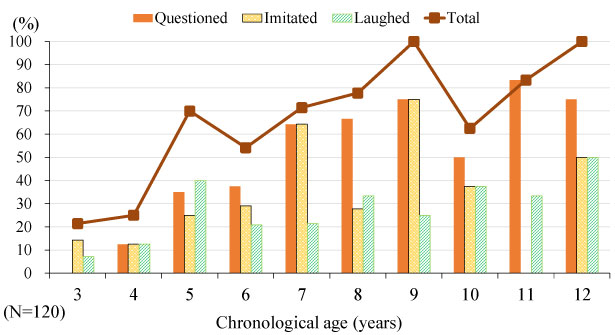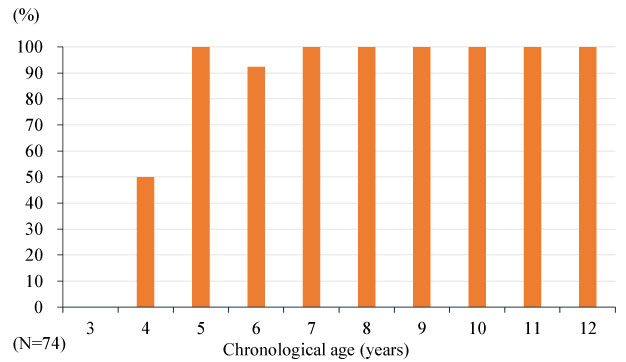This study explores the experiences of children who stutter (CWS) in terms of others imitating or questioning them, or laughing at their speech patterns.
Participants were 120 CWS, aged 3-12 years, who were patients at our hospital. Each child was asked the following three questions: Has anyone asked you why you speak in that way? (questioned); has anyone imitated the way you speak? (imitated); and has anyone laughed at your speech? (laughed). We also asked if the CWS felt unhappy or happy about these responses.
The total proportion of children who were questioned, imitated, and laughed at was 66.6%. Most of the CWS in the study over 4-years-old felt unhappy with any of these responses to stuttering.
We found that even at age 4, CWS remembered non-friendly exchanges with their peers. It is important to take action against teasing and bullying through asking CWS about their experiences of being questioned, imitated, or laughed at.
Children who stutter; Prevention; Speech disorder; Teasing; Responses to bullying
CWS: Children Who Stutter
Stuttering is a speech disorder characterized by involuntary repetitions or prolongations of words or syllables, or interruptions in flow of speech, known as blocks [1,2]. Some children may comment on another child's stuttering out of curiosity or interest. Such comments may be hurtful to a child who stutters (CWS), even when bullying was not the intent [3]. The consequences of being bullied and teased during childhood may increase social anxiety, reduce self-esteem, and lead to poorer peer relationships, among other things [4,5]. Indeed, at least 40% of adults who stutter also have a social anxiety disorder [6]. Early detection and prevention of teasing and bullying associated with stuttering is therefore needed.
Although the terms bullying and teasing are often used interchangeably, it is helpful to distinguish them [7]. In Japan, bullying refers to non-friendly exchanges between peers; this definition is based on legislation aimed at preventing bullying at elementary, junior high, and senior high schools [8]. Teasing, on the other hand, refers to an enjoyable exchange between friends, without any malicious intent. Stuttering typically arises in children aged 2-4 years, and according to parents' questionnaire, children as young as 2-years-old have been found to be aware of their own stuttering [9]. Bullying behavior can be ranked from mild to severe; imitation is classified as mild bullying [10]. In addition to being imitated, CWS are also often questioned and laughed at. The aim of this study was to interview CWS aged 3-12 years on their experiences of being questioned, imitated, or laughed at, and to determine whether these incidents left them feeling unhappy.
Participants were 120 CWS (98 male and 22 female) between ages 3 and 12, who visited Kyushu University Hospital from 2012 to 2017 for consultations on their stuttering. The age distribution was as follows: 14 three-year-olds (12 male, 2 female); 8 four-year-olds (all male); 20 five-year-olds (14 male, 6 female); 24 six-year-olds (21 male, 3 female); 14 seven-year-olds (11 male, 3 female); 18 eight-year-olds (13 male, 5 female); 4 nine-year-olds (3 male, 1 female); 8 ten-year-olds (7 male, 1 female); 6 eleven-year-olds (all male); and 4 twelve-year-olds (3 male, 1 female). On first consultation, we asked each child the following three questions:
• Has anyone asked you why you speak in that way?
• Has anyone imitated the way you speak?
• Has anyone laughed at your speech?
We also asked if they felt unhappy or happy about these incidents. This study was approved by the institutional review board of Kyushu University (29-117) and was performed in accordance with the Declaration of Helsinki.
The proportion of CWS who were questioned, imitated, or laughed at is depicted in Table 1 and Figure 1. The average proportion of children who were questioned was 44.2% (0% at age three; 13% at age four; 35% at age five; 38% at age six; 64% at age seven; 67% at age eight; 75% at age nine; 50% at age ten; 83% at age eleven; and 75% at age twelve), those who were imitated was 30.8% (14% at age three; 13% at age four; 25% at age five; 29% at age six; 64% at age seven; 28% at age eight; 75% at age nine; 38% at age ten; 0% at age eleven; and 50% at age twelve), and ones who were laughed at was 26.7% (7% at age three; 13% at age four; 40% at age five; 21% at age six; 21% at age seven; 33% at age eight; 25% at age nine; 38% at age ten; 33% at age eleven; and 50% at age twelve). The total proportion of children who were questioned, imitated, and laughed at was 66.6% (21% at age three; 25% at age four; 70% at age five; 54% at age six; 71% at age seven; 78% at age eight; 100% at age nine; 63% at age ten; 83% at age eleven; and 100% at age twelve). There were no gender differences.
 Figure 1: The proportion of CWS who had been questioned about their speech patterns, imitated, or laughed at by others.
View Figure 1
Figure 1: The proportion of CWS who had been questioned about their speech patterns, imitated, or laughed at by others.
View Figure 1
 Figure 2: The proportion of CWS who were "unhappy" with being questioned, imitated, or laughed at, according to age.
View Figure 2
Figure 2: The proportion of CWS who were "unhappy" with being questioned, imitated, or laughed at, according to age.
View Figure 2
Table 1: Detailed proportion of CWS who had experienced being questioned about their speech pattern, imitated, or laughed at by others. View Table 1
The percentage of CWS who were unhappy with being questioned, imitated, or laughed at is depicted in Figure 2. The distribution of CWS who were unhappy, was 0% at age three; 50% at age four; 100% at age five; 92.3% at age six; 100% at age seven; 100% at age eight; 100% at age nine; 100% at age ten; 100% at age eleven; and 100% at age twelve.
This is the study to ask CWS as young as age three and over about their attitudes to being questioned, imitated, or laughed at regarding their stuttering. The proportion of CWS who were questioned exceeded those who were imitated or laughed at. Ezrati-Vinacour et al [11] reported that preschool children with normal fluency are fully aware of stuttering-like disfluencies at age five. Half of four-year-old CWS did not feel unhappy about being questioned, imitated, or laughed at. We recommend that physicians and speech language pathologists ask CWS over age four whether they were questioned, imitated, or laughed at, to detect bullying associated with stuttering.
We did not find three-year-olds who felt unhappy with being questioned, imitated, or laughed at. Boey et al [9] found that children are aware of their own stuttering from as early as two years old, based on parental-reported unambiguous verbal and non-verbal reactions in response to stuttering. However, the study by Boey et al [9] explored difficulties of CWS from the perspective of parents, while our study examined children's memories of experiences with their peers. The difference in findings may be related to children's ability to process experiences and emotions, which increases with age.
There are some studies on bullying detection. Langevin et al [10], with the help of 19 items of The Teasing/Bullying Questionnaire for Children Who Stutter (TBQ-CS), reported that nearly 60% of children aged 7-15, who stuttered frequently, experienced bullying behaviors. Blood and Blood [4] examined adults who stuttered, using 46 items of the Retrospective Bullying Questionnaire (RBQ); their findings showed that 30.6% of participants were bullied in primary school, 27.8% in secondary school, and 11.1% in university. Furthermore, Hugh-Jones and Smith [12] reported that 75% of adults who stuttered believed that the bullying they experienced in school had affected their academic performance. There were many strategies of addressing bullying [3,13] and Yaruss et al [14] summarized six key steps to prevent and minimize bullying: (1) Educating children about stuttering; (2) Educating children about bullying; (3) Helping children change the way they think and feel about their stuttering through desensitization, cognitive restructuring, and acceptance activities; (4) Helping children learn to use appropriately assertive responses that decrease the likelihood of bullying; (5) Educating peers and bystanders about stuttering and bullying so that they are more likely to respond in helpful ways; and (6) Educating parents, teachers, and administrators about how they can create an environment where it is not okay to bully, but it is okay to stutter.
The limitation of this study was the lack of data on stuttering severity of the participants, and it is likely that more severe stuttering may lead to an increase in bullying severity. However, even CWS who had a minimal stutter in our examination were bullied by their classmates; stuttering severity may not be the only factor determining the severity of bullying.
• A large proportion of children who stutter are questioned, imitated, and laughed at.
• Children who stutter are bullied from as young as four-years-old.
• Bullying impacts people who stutter into adulthood.
• Psychological effects of bullying should be addressed by holistic treatment.
This work was supported by Grant-in-Aid for Young Scientists (B) 17K16922 and Japan Agency for Medical Research and Development (AMED) 17dk0310066h0202 and 19dk0310102j0001. We would like to thank Editage (www.editage.jp) for English language editing.
The authors have no conflicts of interest to disclose.